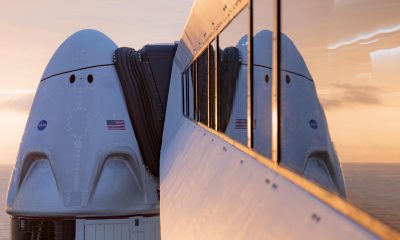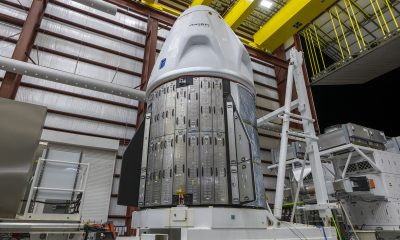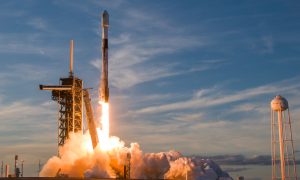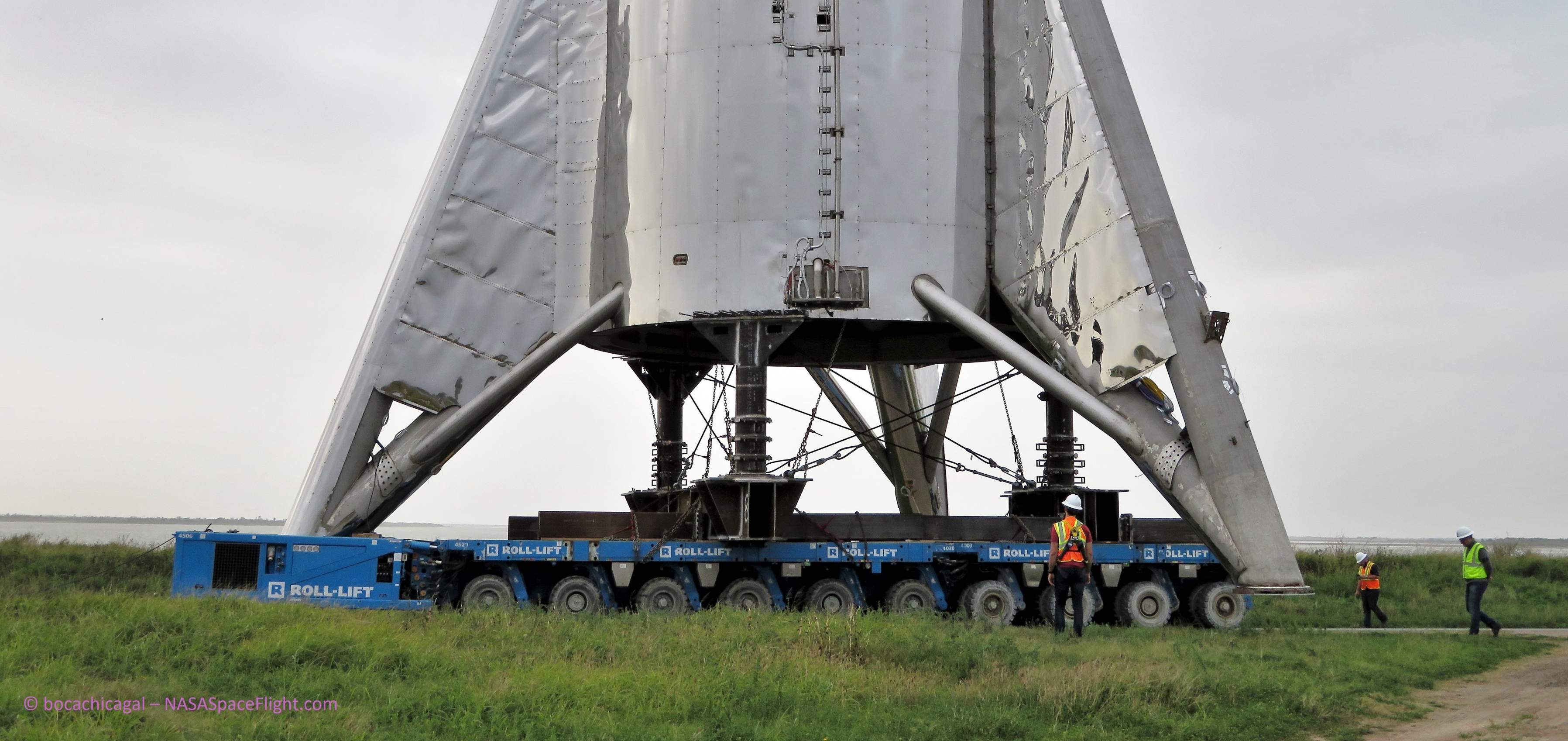

SpaceX
SpaceX’s Starship prototype moved to launch pad on new rocket transporter
Over the last two or so weeks, SpaceX engineers and technicians have continued to make progress on the company’s first full-scale Starship prototype, intended to support experimental suborbital hop tests as early as March or April.
That work reached a peak on March 8th when the massive Starhopper was transported from build site to launch pad on a brand new transporter that was delivered and assembled barely 48 hours prior. Ahead of the suborbital prototype’s move, work has been ongoing to construct a replacement fairing for the partial-fidelity vehicle, although there is a chance that the new BFR-related stainless steel sections being assembled could be the start of the first orbital Starship prototype.
Required after improper planning destroyed Starship’s original nosecone (or fairing) when it broke free from its insufficient moorings during high coastal winds, the replacement has sprouted from sheets of metal into a far more substantial structure in barely two weeks. Designed as two integral parts of a suborbital Starship prototype, the upper section (i.e. fairing, nosecone, etc.) is predominately a passive aerodynamic structure with no major active functions, thankfully meaning that the first article’s accidental destruction was a relatively minor loss.
In fact, it’s entirely possible that the fairing’s demise has had a minimal impact on the commencement of hop tests, and may have even been a net-good for the program given some visible differences between Starship fairings #1 and #2. Despite the fact that the first fairing was destroyed in late January and a comment from CEO Elon Musk indicating that it would trigger a delay of a few weeks, SpaceX did not begin to assemble its replacement until February 21st, a full month later. Over the course of those 30 or so days, the company’s propulsion team simultaneously began hot-fire tests of the first full-scale Raptor engine, ramped thrust and chamber pressure from roughly 40 to 100 percent, and ultimately pushed the engine to the point of damage around the second week of February.
Work on the primary structure of the Starship prototype also proceeded apace, fleshing out the brute-force steel vehicle with the beginnings of serious avionics and plumbing and more or less completing the structure of its liquid oxygen and methane propellant tanks. SpaceX workers also rapidly expanded and built-out Starship’s prospective hop test launch pad just a few thousand feet distant, installing tank farms, piping, water deluge hardware, and building an actual concrete ‘pad’ with umbilical connection ports and attachment points for the ship’s three fin-legs.

Welding and assembly of the replacement nosecone began around February 21st, rapidly growing from a few sheets of steel to a nearly-complete barrel section measuring about 9m tall and 9m in diameter (30ft x 30ft). Intriguingly, the new fairing appears to be a significant departure from the structural composition of its predecessor, utilizing far thicker sheets of stainless steel joined by uninterrupted width and lengthwise welds. Compared to the first fairing’s dependence on extremely thin (nearly foil-like) steel sheets and a separate internal framework of metal bars, Starship fairing V2 appears to be easily capable of standing under its own weight and then some. While largely passive, it’s likely that once the structure is complete, some level of additional avionics (and perhaps cold or hot-gas maneuvering thrusters) will be installed inside.
Heres a close up of the launch site. pic.twitter.com/Q32SHjUH8F— RGVAerialPhotography (@RGVaerialphotos) March 4, 2019
U-Crawl
Keeping in the practice of dramatically lowering costs by prioritizing consumer off-the-shelf (COTS) hardware solutions wherever possible, SpaceX has purchased or leased a quartet of (likely used) crawlers for the purpose of transporting Starship between the company’s South Texas build, launch, and landing sites. Built by a European conglomerate known TII Group and owned by US-based Roll Group, SpaceX’s four crawlers – coupled to form a duo of larger crawlers – should be more than capable of transporting anywhere from 500t to 1000t or more, easily supporting Starhopper and/or Starships and Super Heavy boosters.

Rather than spending huge amounts of money to develop or contract out a custom-designed crawler or transporter solution for BFR, SpaceX appears to have simply purchased off-the-shelf hardware and affixed them with heavy steel structures capable of securing and supporting Starhopper during transport. Within 24 hours of the crawler arrivals, those beams were installed and the transporter had been moved underneath Starhopper and attached to it before quite literally jacking the massive ship off the ground, allowing technicians to weld additional structures to the tips of its three legs.

Last but not least…
Perhaps most curious of all, Starhopper’s replacement fairing was recently joined by the start of work on a separate barrel section that appears to be nearly identical. Assuming the presumed fairing is, in fact, a fairing-to-be, the combined height of the two barrel sections would already make it significantly taller than the original nosecone, and the beginning of the conical taper has yet to appear on either assembly. This could generally mean one of two things. First, the new fairing could make Starhopper much taller than its short-lived predecessor. Second, SpaceX could be planning to begin (or even complete) hop tests without a fairing, in which case the presumed fairing and its slightly younger twin could actually be the beginning of a higher-fidelity Starhopper or even the orbital Starship prototype hinted at by Musk earlier this year.
While far less likely than the first option, the latter alternative is further supported by the fact that visible work has begun on some sort of tapered or curved steel complements to the new sections in work. While they certainly could be the beginning of the fairing’s tapered cone, the latest segments only loosely resemble the start of a gradual curve. Instead, they look similar to the steel segments of several giant tank domes that were assembled, welded, and installed inside Starhopper last month.


On March 8th, SpaceX began the transport of its first full-scale Starship prototype at the same time as CEO Elon Musk indicated that the first flightworthy Raptor(s) would be delivered to South Texas and installed on the hop test article as early as next week (March 11-17). It’s now looking increasingly likely that any replacement fairing that may or may not be under construction might not be ready for installation on Starhopper before SpaceX begins integrated static-fire tests and maybe even low-altitude tethered hop tests.
“SpaceX will conduct checkouts of the newly installed ground systems and perform a short static fire test in the days ahead,” he said. “Although the prototype is designed to perform sub-orbital flights, or hops, powered by the SpaceX Raptor engine, the vehicle will be tethered during initial testing and hops will not be visible from offsite. SpaceX will establish a safety zone perimeter in coordination with local enforcement and signage will be in place to alert the community prior to the testing.” – James Gleeson, March 8th, SpaceX
Check out Teslarati’s Marketplace! We offer Tesla accessories, including for the Tesla Cybertruck and Tesla Model 3.
News
SpaceX produces its 10 millionth Starlink kit
The first 5 million Starlink kits took nearly four years to build.

SpaceX has achieved a major milestone, producing its 10 millionth Starlink kit. The accomplishment was celebrated across the company’s Hawthorne, California, and Bastrop, Texas, facilities.
The milestone was shared in social media by Sujay Soman, Senior Facilities Engineer, in a LinkedIn post, which has since been deleted.
Starlink Production Ramp
Soman noted in his LinkedIn post that the first 5 million Starlink kits took nearly four years to build, but the next 5 million kits were completed in just 11 months. This underscores SpaceX’s intense efforts to ramp up the satellite internet system’s production, and it reflects the private space company’s manufacturing prowess.
The SpaceX Senior Facilities Engineer shared a couple of photos of the Machine Maintenance and Facilities team in Bastrop to commemorate the event.
“Today, Starlink Product teams across our Hawthorne and Bastrop sites produced the 10th Million Starlink Kit! It took almost 4 years to build our first 5 million kits, and we doubled that in about 11 months. Monumental accomplishment!” Soman wrote in his post.
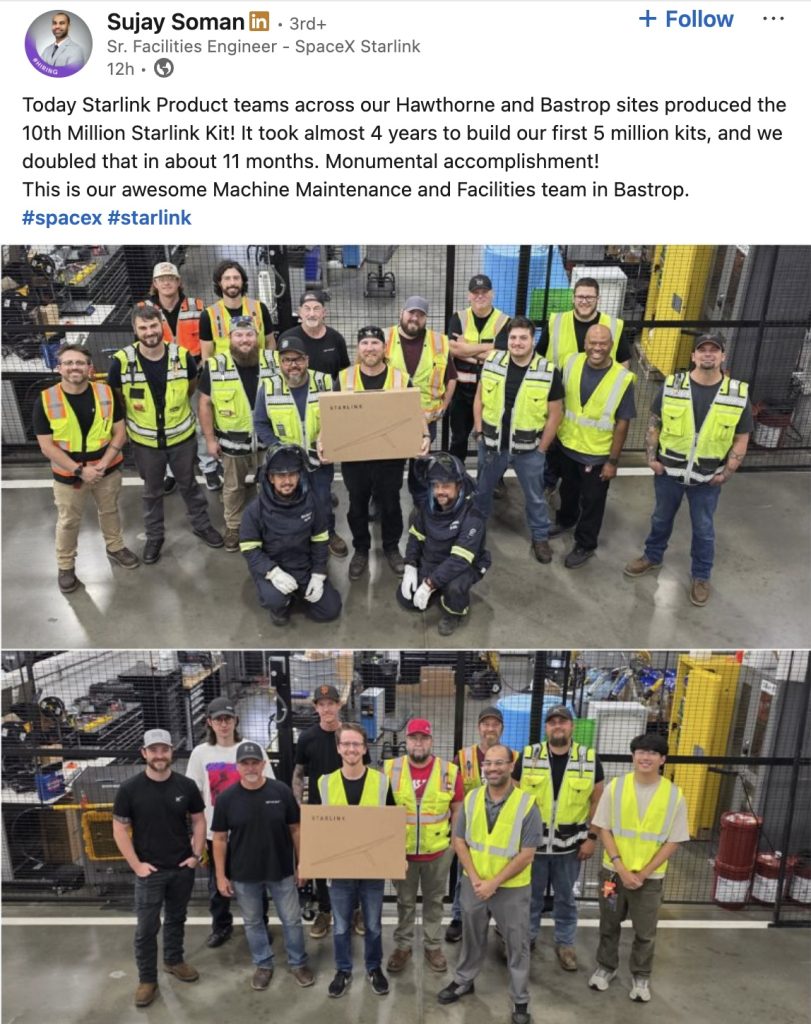
World-Changing Technology
The Starlink kits, featuring dish hardware and supporting equipment, enable users to connect to the company’s growing constellation of low Earth orbit satellites. With over 6,000 satellites launched to date, Starlink now provides fast and reliable internet connectivity to over 6 million customers worldwide. This was a significant increase from the 5 million customers that the company reported in February 2025.
SpaceX has not detailed its next production targets, but the production of Starlink’s 10 millionth kit milestone signals the company’s readiness to scale further. Being an Elon Musk-led company, SpaceX is arguably the best in the business when it comes to efficient and cost-effective manufacturing. It would then be unsurprising if SpaceX announces another Starlink production milestone soon.
News
Starlink India launch gains traction with telecom license approval
Starlink just secured its telecom license in India! High-speed satellite internet could go live in 2 months.

Starlink India’s launch cleared a key regulatory hurdle after securing a long-awaited license from the country’s telecom ministry. Starlink’s license approval in India paves the way for commercial operations to begin, marking a significant milestone after a three-year wait.
The Department of Telecommunications granted Starlink a Global Mobile Personal Communication by Satellite (GMPCS) license, enabling it to roll out its high-speed internet service. Local reports hinted that Starlink plans to launch its services within the next two months. Starlink India’s services are expected to be priced at ₹3,000 per month for unlimited data. Starlink service would require a ₹33,000 hardware kit, including a dish and router.
“Starlink is finally ready to enter the Indian market,” sources familiar with the rollout plans confirmed, noting a one-month free trial for new users.
Starlink’s low-Earth orbit satellite network promises low-latency, high-speed internet that is ideal for rural India, border areas, and hilly terrains. With over 7,000 satellites in orbit and millions of global users, Starlink aims to bridge India’s digital divide, especially in areas with limited traditional broadband.
Starlink has forged distribution partnerships with Indian telecom giants Reliance Jio and Bharti Airtel to streamline deployment and retail logistics. However, the company still awaits spectrum allocation and final clearances from India’s space regulator, IN-SPACe, and national security agencies before its full launch, expected before August 2025.
India’s satellite internet market is becoming increasingly competitive, with Starlink joining rivals like OneWeb and Jio Satellite Communications. While Starlink positions itself as a premium offering, its entry has sparked debate among domestic telecom operators over spectrum pricing.
Local reports noted that other players in the industry have raised concerns over the lower regulatory fees proposed for satellite firms compared to terrestrial operators, highlighting tensions in the sector.
Starlink India’s launch represents a transformative step toward expanding internet access in one of the world’s largest markets. Starlink could redefine connectivity for millions in underserved regions by leveraging its advanced satellite technology and strategic partnerships. As the company navigates remaining regulatory steps, its timely rollout could set a new standard for satellite internet in India, intensifying competition and driving innovation in the telecom landscape.
News
SpaceX to debut new Dragon capsule in Axiom Space launch
Ax-4’s launch marks the debut of SpaceX’s latest Crew Dragon and pushes Axiom closer to building its own space station.
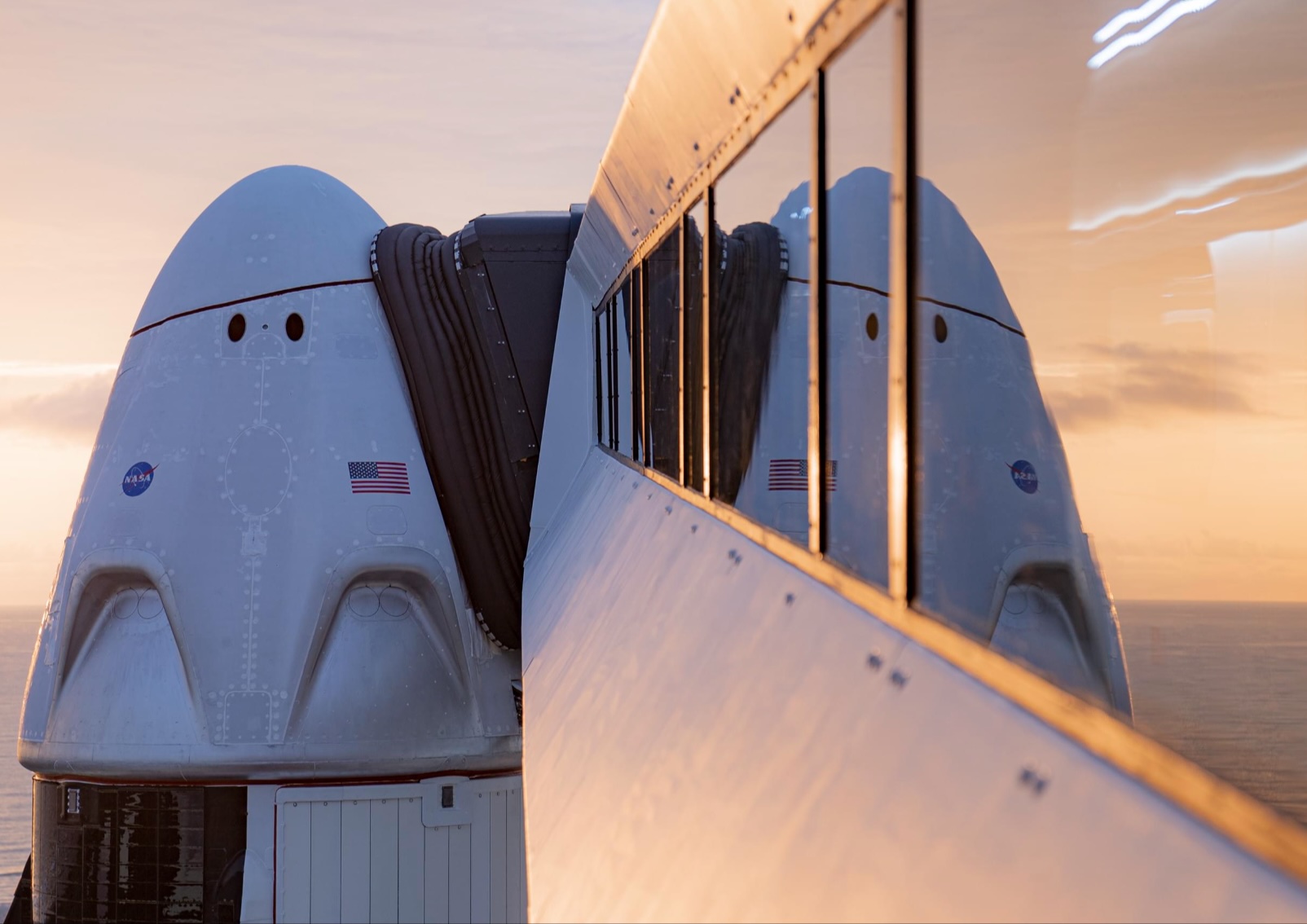
Axiom Space’s Ax-4 mission targets the International Space Station (ISS) with a new SpaceX Crew Dragon capsule.
The Axiom team will launch a new SpaceX Dragon capsule atop a Falcon 9 rocket from NASA’s Kennedy Space Center in Florida on Wednesday at 8:00 a.m. EDT (1200 GMT). The Ax-4 mission launch was initially set for Tuesday, June 10, but was delayed by one day due to expected high winds.
As Axiom Space’s fourth crewed mission to the ISS, Ax-4 marks the debut of an updated SpaceX Crew Dragon capsule. “This is the first flight for this Dragon capsule, and it’s carrying an international crew—a perfect debut. We’ve upgraded storage, propulsion components, and the seat lash design for improved reliability and reuse,” said William Gerstenmaier, SpaceX’s vice president of build and flight reliability.
Axiom Space is a Houston-based private space infrastructure company. It has been launching private astronauts to the ISS for research and training since 2022, building expertise for its future station. With NASA planning to decommission the ISS by 2030, Axiom has laid the groundwork for the Axiom Station, the world’s first commercial space station. The company has already begun construction on its ISS replacement.
The Ax-4 mission’s research, spanning biological, life, and material sciences and Earth observation, will support this ambitious goal. Contributions from 31 countries underscore the mission’s global scope. The four-person crew will launch from Launch Complex 39A, embarking on a 14-day mission to conduct approximately 60 scientific studies.
“The AX-4 crew represents the very best of international collaboration, dedication, and human potential. Over the past 10 months, these astronauts have trained with focus and determination, each of them exceeding the required thresholds to ensure mission safety, scientific rigor, and operational excellence,” said Allen Flynt, Axiom Space’s chief of mission services.
The Ax-4 mission highlights Axiom’s commitment to advancing commercial space exploration. By leveraging SpaceX’s Dragon capsule and conducting diverse scientific experiments, Axiom is paving the way for its Axiom Station. This mission not only strengthens international collaborations but also positions Axiom as a leader in the evolving landscape of private space infrastructure.
-

 News7 days ago
News7 days agoI took a Tesla Cybertruck weekend Demo Drive – Here’s what I learned
-
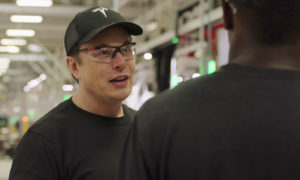
 Elon Musk2 weeks ago
Elon Musk2 weeks agoElon Musk explains Tesla’s domestic battery strategy
-

 Elon Musk2 weeks ago
Elon Musk2 weeks agoTesla stock: Morgan Stanley says eVTOL is calling Elon Musk for new chapter
-

 Elon Musk1 week ago
Elon Musk1 week agoTesla tops Cathie Wood’s stock picks, predicts $2,600 surge
-

 Elon Musk2 weeks ago
Elon Musk2 weeks agoElon Musk responds to Tesla Supercharger shutdown on NJ Turnpike
-
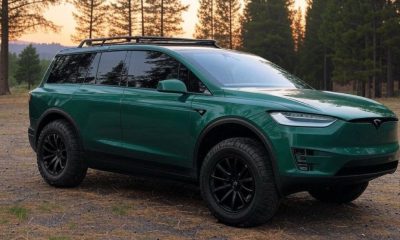
 News2 weeks ago
News2 weeks agoTesla is missing one type of vehicle in its lineup and fans want it fast
-
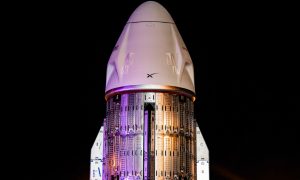
 Elon Musk2 weeks ago
Elon Musk2 weeks agoSpaceX to decommission Dragon spacecraft in response to Pres. Trump war of words with Elon Musk
-

 Elon Musk1 week ago
Elon Musk1 week agoX account with 184 followers inadvertently saves US space program amid Musk-Trump row






